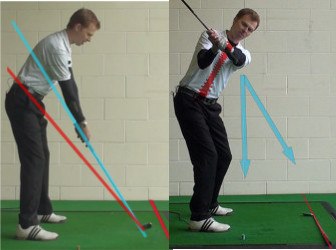
The Golf Term: Swing Plane
One of the most important concepts in golf is the notion of the swing plane. Understanding and maintaining the correct swing plane can greatly impact your consistency, power, and accuracy on the golf course. Let's delve deeper into this fundamental aspect of the golf swing:
-
Definition:
The swing plane refers to the path or plane on which the golf club head travels during the swing. It is an imaginary inclined plane that extends from the ball at address and extends up and through the golfer's body. The swing plane can be visualized as an inclined hula hoop that surrounds the golfer.
-
Importance:
Maintaining a consistent swing plane is crucial because it affects the arc, angle, and direction of the clubhead during impact. A proper swing plane allows for better contact with the ball and maximizes the potential for a solid shot. It also minimizes the chance of slicing or hooking the ball.
-
Key Elements:
There are a few key elements to understand when it comes to the swing plane:
- Address Position: It is essential to set up with a proper address position where the spine is tilted forward, the knees are slightly flexed, and the arms hang naturally.
- Backswing: During the backswing, the club should be taken away on a path parallel to the target line, following the swing plane. This ensures that the club remains on the proper plane and sets up the correct downswing.
- Downswing: As the golfer transitions into the downswing, the club should return to the original swing plane and approach the ball from the inside. A shallower approach minimizes the chance of hitting down on the ball too steeply.
- Follow-Through: A proper swing plane continues through to the follow-through. The club should extend along the original swing plane and finish at a balanced position with the body facing the target.
-
Common Swing Plane Issues:
Here are some common swing plane issues that golfers often encounter:
- Steep Swing Plane: A steep swing plane occurs when the club is lifted too vertically during the backswing, resulting in an over-the-top downswing. This leads to slices and weak shots.
- Flat Swing Plane: Conversely, a flat swing plane happens when the club is swung too shallowly and too far behind the golfer. This can result in hooks and inconsistent strikes.
- Outside-In Swing Plane: An outside-in swing plane occurs when the downswing approaches the ball from outside the target line. It often leads to slices and pulls.
- Inside-Out Swing Plane: On the other hand, an inside-out swing plane happens when the downswing approaches the ball from inside the target line. It can lead to hooks and pulls.
-
Practice and Improvement:
Improving your swing plane requires practice and awareness. Utilize drills, training aids, and feedback from a professional instructor to develop a consistent swing plane. Video analysis can be a valuable tool in identifying and correcting swing plane issues.
Remember, a proper swing plane is essential for a consistent and powerful golf swing. By understanding and working on your swing plane, you'll be well on your way to improving your overall game and enjoying greater success on the golf course!





